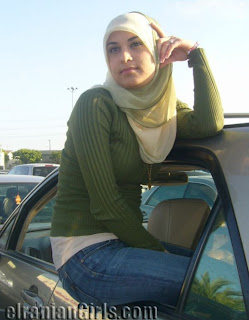Under the Islamic Republic of Iran
See also: Iranian
women's movement
Following the 1979 Islamic Revolution Iran became an Islamic Republic.During this era of Islamist rule Iranian women have had more opportunity in some areas and more restrictions in others. One of the striking features of the revolution was the large scale participation of women from traditional backgrounds in demonstrations leading up to the overthrow of the monarchy. The Iranian women who had gained confidence and higher education under Pahlavi era participated in demonstrations against Shah to topple monarchy, not knowing that the regime to follow would strip them from their human rights. Hijab became compulsory (although this had not been mentioned during the revolution). The culture of education for women was established by the time of revolution so that even after the revolution, large numbers of women entered the civil service and higher education, and in 1996 fourteen women were elected to the Islamic Consultative Assembly. In 2003, Iran's first woman judge in Pahlavi era, Shirin Ebadi, won Nobel Peace Prize for her efforts in promoting human rights.
According to UNESCO world survey, at primary level of enrollment Iran has the highest female to male ratio in the world among sovereign nations, with a girl to boy ratio of 1.22 : 1.00. By 1999, Iran had 140 female publishers, enough to hold an exhibition of books and magazines published by women. As of 2005, 65% of Iran's university students and 43% of its salaried workers were women. and as of early 2007 nearly 70% of Iran's science and engineering students are women. This has led to many female school and university graduates being under-utilised. This is beginning to have an effect on Iranian society and was a contributing factor to the anti-regime protests by Iranian youth.
Women make up almost 30% of the Iranian labor force, and the percentage of all Iranian women who are economically active has more than doubled from 6.1% in 1986 to 13.7% in 2000.As well 27.1% of the ministers in government are women (ranks 23rd out of 125 countries) and 3.4% are parliamentarians (140th out of 157 countries).In 2009 Fatemeh Bodaghi became Vice President for Legal Affairs and a top advisor to President Mahmoud Ahmedinejad.Maryam Mojtahidzadeh who runs the women's ministry was also selected as an advisor to the president.
At least one observer (Robert D. Kaplan) has commented on the less traditional attitude of many women in Iran compared to other Muslim countries. "In Iran, you could point a camera at a woman ... and she would smile" in contrast to other more conservative places where women may mind this.
However, the Islamic regime has placed a number of restrictions on women's dress and behavior. At the beginning of the revolution, it was announced that women appearing on television would have to wear the hijab, (also known as rousari). A couple of months later it was announced that women working in government facilities and buildings would also be required to wear hijab, and a few months after that that all women had to wear the hijab in public. Separation of the sexes was also instituted so that now, everything from "schoolrooms to ski slopes to public buses" are strictly segregated by gender, though such rules have reportedly been relaxed somewhat in recent years.
Restrictions on women have varied over the history of the Islamic Republic. In the first years after the revolution, females who didn't cover all parts of their body, except hands and face, were subject to punishment of up to seventy lashes or sixty days imprisonment.During the presidency of Mohammad Khatami restrictions became less severe but hard-liners have attempted to roll back reforms of that era. As of late 2011 Women and girls were no longer allowed to ski in the absence of a husband, father or brother—ski resorts having been "something of a haven from the Islamic dress code" and from laws enforcing separation of boys and girls.
There are also women in the Iranian police who deal with crimes committed by women and children.
In 1997 women defied the ban on entering soccer stadiums in an act of protest against sex segregation. During the so-called "soccer revolution" an estimated 5,000 women stormed the gates of the national stadium to join 120,000 men in celebration of Iran's national football team which had returned to the country after participating in the 1998 World Cup.
On August 20, 2012, 36 universities announced that 77 courses would become male-only for the following school year, placing restrictions on female university students that were attending.
Politics
Women in Iran were granted the right to vote in 1963. They were first admitted to Iranian universities in 1937. Since then, several women have held high-ranking posts in the government or parliament. Before the 1979 revolution, several women were appointed ministers or ambassadors. Farrokhroo Parsa was the first woman to be appointed Minister of Education in 1968 and Mahnaz Afkhami was appointed Minister for Women's Affairs in 1976.Some, such as Tahereh Saffarzadeh, Masumeh Ebtekar, Azam Taleghani, Fatemeh Haghighatjou, Elaheh Koulaei, Fatemeh Javadi, Marzieh Dabbaq and Zahra Rahnavard came after the revolution. Other Iranian women, including Goli Ameri and Farah Karimi hold positions in Western countries.
About 8% of the Iranian parliament are women, while the global average is 13%.
Iranian women
See also: List of Iranian
women
Over recent years, women in Iran, whether Nobel laureates like Shirin Ebadi who became the
first Muslim woman to win the prize, or young Ivy League professors such as Maryam Mirzakhani,
have "achieved greatly in areas like education, political participation, and
social mobilization, and have made great strides in terms of entering different
fields of academia". The gallery below is only a random sampling.




























No comments:
Post a Comment